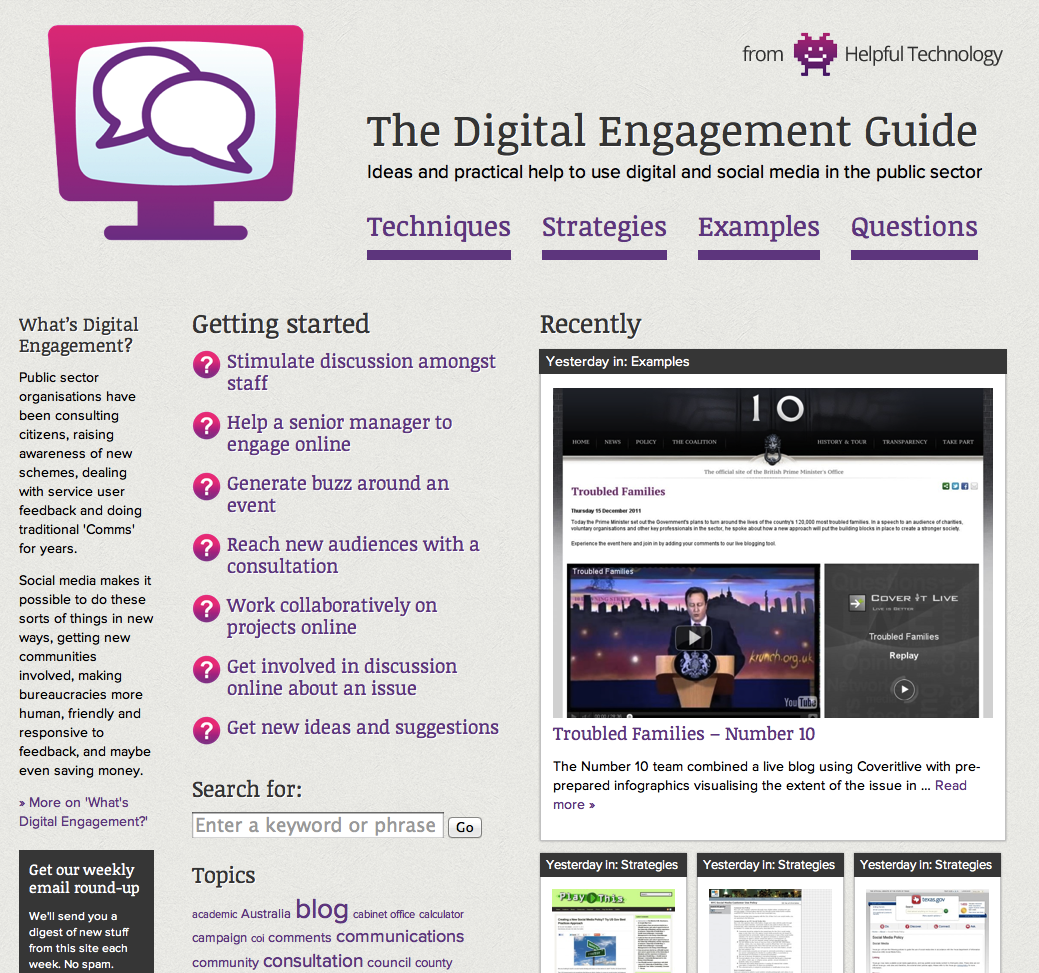(Photo credit: thinkpanama)
At work, I get a fair few people come and try and sell me their thing. Some are better at it than others. Here are eight tips on how to sell me stuff (and if you’re smart enough to find these before you contact me, you’ll be well on the way):
1. Don’t cold call me.
I know cold calling is probably an efficient way to reach consumers, but phone has to be a bad way to make a business sale. The people who’ll speak to you probably don’t have the budgets, and the people who do will be annoyed that you stole the few minutes they have at their desk between meetings.
2. Get to know me through social media (but don’t creep me out)
I’m a dead easy target, because I talk about so many of the things I’m working on, the people I work with, and the problems I face here and across the social web. When I meet a potential supplier who’s read my blog, we save ten minutes each and have a more interesting conversation. That said, I had a slightly freaky (cold) call recently from a vendor who’d clearly been randomly sampling my blog and blogroll in order to drop names and quotes into the patter. Thanks, but no thanks.
3. Go where I go, talk to me about the other things you’re doing
I’ve barely spoken to some of the suppliers I have the most favourable impression of: I feel I know them and their work from the barcamps, events, blogs and online magazines I follow. I’m actually fairly receptive to a simple, factual email now and then about the work you’re doing, new products you’ve developed, conferences you’ve presented at (with links to your material) and so on.
4. Have a demo, a tour and a feature list
If you’re selling software, this is important. Depending on the tool, how much I need it and how innovative it is, I might want to start with an online demo I can play with in my own time (often, I’ll just forward it to home, to play with of an evening) – I’ll definitely want this before I buy. Occasionally, I may watch a ‘tour’ video, but again, probably not at work where video performance isn’t great. But I almost always need a feature list – preferably a page on your site – which gives me an impression in 10 seconds what the tool does, and gives me something I can send on to colleagues if I want to get them interested. A smart vendor will have all three, publicly available on their site.
5. Give me some ballparks
I know, I know. Tell the client it will cost roughly X and when they’ve given you their full requirements and it actually costs X+Y, they turn round and say: “But you said it would cost X?”. I’ve been on both sides of that in the past. Frequently, I have little or no budget right now, but I may do in the future if the right project comes along. But without a ballpark, I’ll struggle to assess the kind of value I’m expecting from your product, I’ll have no idea whether I can afford it or should suggest it to a colleague, and we’ll waste both of our time. If it’s highly configurable, say: “Client A bought a mid-range package to do X, Y and Z and it cost them between £5,000-£10,000”. Ranges are fine.
6. Tell me about you and UK government
I’m a central government prospect, so tell me about your work with government. Mention some clients you’ve worked with and describe or show me screenshots of the kind of projects you did with them. Tell me what government standards or accreditations you’ve achieved, and about the procurement frameworks you’ve got onto which I might be able to buy through if things go well.
7. The biography goes at the end
It’s not that I’m not interested in your slides of big-name client logos, org charts, parent company details, awards, shortlistings, staff profile, company history, chief executive’s photo, office locations, mission statement, core values or brand essence… actually, it is. Above all, it’s a bad way to spend the first twenty minutes of our meeting, even if I eventually want to know some of that stuff. I’ll be impressed if you kick off with the product and what it does in a nutshell. Then tell me some stories about how it’s been used by your different clients – and if you’re brave, where it hasn’t worked so well and why. Give me an idea of the kind of costs involved. And then tell me why, since the company behind it all is so ace, I’d be a fool to miss out.
8. The killer email
So what’s the best way to approach me? Probably a well-crafted tweet, or more likely a good email that reads something like:
Hi Steph
I hope you don’t mind me getting in touch. I’m a big fan of your [insert adjective flattery here] blog. I read your post recently about [some fascinating topic] and I thought the responses to the comment I left were really interesting.
As I mentioned on the blog, I’m sales director at CoolStartup.com, a UK startup which offers an unusual online contact management tool called CrazeeName. It’s different from ThingYou’veHeardOf.com in three main ways:
– one: it has cool features A, B and C – and it even works on Internet Explorer 6!
– two: our pricing model is based on X which means a simple install starts from £2k up to £10k for our gold package
– three: we’re government accredited to level X and on frameworks A, B and CIf you want to take a look, I’ve set up an online demo for you at: http://coolstartup.com/yourdemo which will work for 30 days, and I’ve attached a summary of what the tool does with a few case studies of how government clients have used it. If you want to know more, head on over to http://coolstartup.com/tour and take a look.
I’ll drop you a line in a couple of weeks to see what you think – perhaps we can set up a meeting then if you want to discuss it further or involve some colleagues?
All the best – see you at CoolSocialMediaEvent09 next week?
V. Smart




Comments
Excellent!
(not flattery, just fact)
Seriously cyberdoyle, you should go into business offering social media monitoring and community management services – you’re the quickest on the draw, 24×7! Thanks for the comment.
Steph – more years than I want to admit to in jobs where I get those random sales calls and I laughed out loud at your blog this evening! Thank you for making my day and giving me some ideas for tactical avoidance!
Alex
Thanks Steph,
by the way, if you ever get your hands on a couple of billion for rural broadband remind me to email you. 😉
keep rockin, you always manage to make the serious stuff funny. Always worth reading.
(again not flattery, will grovel in earnest once you get the billions).
chris
I’m tweeting this. Everyone ought to read it aloud at their weekly staff meeting. Good points.
Adam @Advent Creative Web Design
Been there done it and totally agree with you. If I have another person try to flog me a cms at my non meeting time I’ll scream.
Now wondering how many emails you may receive with a copy and paste approach and the blanks modified to suit their product. Please blog some examples if you get any – that would be funny.
I’ve been on both sides of this fence. I hate cold calls with a passion and anything that seems ‘salesy’ – even a tone of voice, so this really rings true with me. On the other side of the fence I find nothing works better than making yourself useful to people, even when they’re not immediately buying your service. Demonstrating your ‘value-add’ for free can work wonders if you’re able to sit tight and take a long-term approach to working with someone.
Thanks for making me smile on a Saturday morning! If only half of the companies who regularly cold call would read and act on this, then you have just given me more reasons to actually open mails rather than add to the junk filter!
Our regional development agency spent a fortune out of our broadband fund for a company to cold call all the businesses in the area. I was offered a job there as part of the team. It was well paid. I told them I totally disagreed with cold calls, and said all the SMEs in the area would not like it, but they wouldn’t listen to me. I turned down the job, and carry on as a volunteer doing the same job for No Pay. That is how strongly I feel about it, so it is good to know others feel the same. Your post is bringing it up for attention. great stuff.
The comments here are interesting too, agree with Tracy, I would love to see any copypaste emails you receive. If I was a wit I would write one to you. (maybe Neil could do one?)
chris
Sounds like you’ve had a similar experience with sales approaches as me! My list of “things not to do when calling me” ( http://www.markpack.org.uk/things-you-should-know-if-you’re-going-to-make-a-sales-pitch-to-me/ ) still rings all too true alas.
‘@Mark: nice list! I may be being dim… what’s with the colour of the supplier’s office carpet?
Amused by this, especially the timing. On Friday I think I was the rudest I’ve yet been to a cold caller who was being fairly insistent about finding 10 mins sometime to talk to me. I told him that if I gave every sales caller 10 minutes I’d have no week left over. Not *quite* true, but lately it’s not far off.
‘@Steph: It’s a good way of checking if people really read the whole list 🙂 But it’s also a fun way of getting the person at the other end to quickly end the phone conversation without you having to be rude to them.
Very funny – ‘cos its so true. I would have to add ‘get recommended’ to your list, too. Surely the best way to get a foot in the door?
[…] man. But even he has his limits. Tired of cold calls and clumsy pitches, @lesteph has posted eight tips on how to sell him right. I’m ditto on all […]
[…] Gray provides some good advice on his blog on how to sell to government digital media staff. As we are increasingly seeing central and local government using social media technologies to […]
Excellent! Nice hints Steph 🙂
Lets try it as a tweet…
“@lesteph Love your blog. We’ve got a awesome new AWESOMEdo app. Its different as its awesomeful & doesn’t break. Try our beta. Tweet soon” (138 words)
Does that work for you?
B. Startup
[…] find the civil servants who will have to work with you to deliver the idea, and be useful to them. That doesn’t mean hard sell or showering them with hospitality, which are almost entirely counterproductive. In the current […]